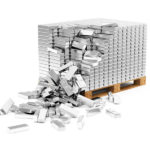Why Gold Could Be Worth $1,700/oz: Deutsche
THANK YOU FOR POSTING A REVIEW!
Your review was sent successfully and is now waiting for our staff to publish it.
(August 30, 2016 - by Shuli Ren)
Gold dropped for a seventh day this morning, heading for the longest run of declines since May, trading at $1,319 an ounce.
Federal Reserve chair Janet Yellen‘s speech at Jackson Hole last Friday contributed to gold’s recent decline. Yellen said the case for a rate hike has strengthened, without specifying whether we would see one in September or December. The odds of a September rate hike has risen to 42% from 22% a week ago, and the odds of a December rate hike soared to 65%, according to Bloomberg.
Gold, as a hedge against central banks’ quantitative easing programs, fell.
It is interesting Deutsche Bank‘s commodity team put up a note on gold, reiterating their view that gold could be worth $1,700 an ounce. Analysts Michael Hsueh and Grant Sporre argue:
The balance sheets of the main four central banks [US, China, Japan, ECB] have expanded by 300% since the beginning of 2005.
Over the same period as the aggregate central bank balance sheet expanded by 300%, global above ground stocks grew by 19% in tonnage terms or c.200% in value terms. If we were to assume that the value of gold should appreciate to keep the overall value of the big four aggregate balance sheet equivalent to that of the value of the above ground gold stocks, then gold should be trading closer to USD1,700/oz.
Deutsche went on to discuss when we would have a sell-off in gold:
The rate of the aggregate balance sheet expansion, versus the gold price momentum highlights some interesting points. Firstly, the gold price is sensitive to the rate of the aggregate balance sheet expansion. Secondly, if the rate of gold price appreciation under or out-performs over a period, there is a subsequent period of the opposite. Lastly, there were two distinct periods over the past 10 years when this correlation broke down. This first period was during the global financial crisis, when gold was sold to meet liquidity requirements, despite a sharp increase in the Fed’s balance sheet. The second period was during April 2013, when gold suffered one of its biggest falls over a period of two days. This occurred at the same time when the Fed indicated that it would end its QE program, and when it was thought that the Bank of Cyprus would have to liquidate its gold holdings to meet debt obligations. However, at the same time there was 400 tonnes of gold placed in the market via the COMEX, which led to a wave of panic selling. Arguably the gold market has taken over two years to recover from this event. Our conclusion however is that as long as the central banks’ balance sheets continue to expand, the gold price should maintain some momentum.
-
Silver Remains On The Defensive Below $27.50 On Easing Middle East Tensions By
Mint State Gold
April 24 2024






